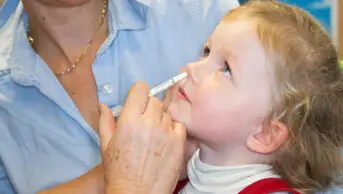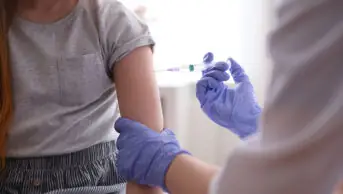Halting an influenza pandemic before the introduction of flu vaccine was an impossible task. Some 20–50 million people worldwide are thought to have died in the outbreak of Spanish flu in 1918–19,1,2 nearly 200,000 of them in England.1 Nearly a century later, the global death toll for the 2009–10 pandemic has been put at 150,000–575,000,2 with fewer than 500 deaths in the UK.3 Although better healthcare and antiviral medicines saved many lives in the recent pandemic,4 vaccination has helped reduce the spread of both seasonal and pandemic flu in the UK for over 50 years.
Jonathan Nguyen-Van-Tam, Professor of Health Protection at the University of Nottingham, highlights the introduction of flu vaccination targets in the elderly in the 1990s as an important turning point in the UK.
“Around the time of the big seasonal influenza A(H3N2) flu epidemic of 1989/90, uptake rates for vaccination were only about 10–20 per cent and people were preoccupied with targeting high risk groups rather than the elderly,” he explains. “It was only when incentivised targets were introduced for GPs in the mid 1990s covering all elderly people, irrespective of underlying chronic illnesses, that rates rose to 70–75 per cent of the elderly, which was about the highest in Europe, and still is except for the Netherlands.”
He adds that uptake remains only 50–60 per cent in people with chronic conditions and it was not until the 2009 pandemic that vaccination among healthcare workers increased from 15 per cent to about 50 per cent.
Chicks, mice and men
Human influenza type A virus was discovered in 19335 and the first vaccine against it described in 1937.6 Minced chick embryo was the medium used to grow the virus, which was taken from infected mice, ready for subcutaneous or intradermal injection into volunteers.
A significant increase in antibody levels was recorded two weeks after injection, and this was maintained for two months, declining at five months.6 Subcutaneous administration triggered a greater reaction than subdermal, and the vaccine was well tolerated, even in patients with colds at the time they were vaccinated. The authors concluded that circulating antibodies might have a protective effect against influenza infection.
When influenza type B was discovered in 1940,2 a combined vaccine was developed and early studies were carried out among recruits to military training programmes at US universities.7 In the influenza type A epidemic of 1943–44, 2.2 per cent of vaccinated soldiers contracted flu, compared with 7.1 per cent of those who were not vaccinated.8
More refined vaccines resulted in better responses so that, a few years later, reported cases of influenza B in army units at Yale and Michigan Universities were 0.5 and 1.1 per cent, respectively, compared with 12.5 per cent and 9.9 per cent in non-vaccinated soldiers at the same respective institutions.8 The duration of protection was uncertain but a reduced incidence of influenza was reported as much as a year after vaccination.8
Who should be vaccinated?
Annual flu vaccination in the UK has recently been extended from the elderly, those with chronic illnesses, immunosuppressed patients and pregnant women to include children aged 2–16 years. Healthy adults are not offered flu vaccination, not least because of the large numbers of people who need to be vaccinated to prevent infection and the lack of impact on demand for healthcare services, resulting in lower cost-benefit.
A recent Cochrane review of randomised controlled trials (RCTs) of inactivated seasonal flu vaccination in healthy adults showed an overall efficacy in preventing confirmed influenza of 60 per cent, with a number needed to vaccinate (NNV) of 719. Vaccination showed no appreciable effect on hospital admissions or working days lost. In pregnant women, the NNV was 27.

Earlier Cochrane analyses have shown that vaccination reduces death in immunosuppressed adults with cancer,10 but cast doubt over the value of vaccinating the elderly.11 In the analysis of trials in the elderly, it was reported that the quality of evidence was too low to draw conclusions about the value of vaccination in this group.12 However, a subsequent re-analysis of the same data by an international consortium, including Professor Nguyen-Van-Tam, suggested that, when virus was circulating, vaccination reduced influenza-related and non-fatal complications by about 30 per cent and cases of confirmed influenza by about 50 per cent.12
Professor Nguyen-Van-Tam explains that the Cochrane review cut the data so finely in over 100 stand-alone meta-analyses that no overall message emerged. But, when the data were cut more coarsely, according to broader outcome measures and whether influenza was actually circulating or not, far higher efficacy was estimated in the elderly, together with reduced hospital admission rates.
“Influenza vaccine isn’t perfect but it’s probably 50–60% effective in the elderly. That’s rather less than for healthy adults, but older people with respiratory infections recover more slowly and spend more time in hospital than younger people so the cost-benefit of vaccination increases substantially,” says Professor Nguyen-Van-Tam.
Paediatric data have shown that, in children aged two years or younger, inactivated vaccines are not significantly more effective than placebo.13 However, when live attenuated vaccine is used, six children under the age of six need to be vaccinated to prevent one case of influenza; for children over the age of six the NNV rises to 28.
Professor Nguyen-Van-Tam believes there is still a need to encourage more healthcare workers to be vaccinated as recent evidence suggests that this can protect patients from infection, especially in long-term care facilities.14
Seasonal and pandemic vaccines
Today’s flu vaccines are still mainly produced using fertilised chicken eggs. And the identification of haemagglutinin (HA) and neuraminidase (NA) antigens on the surface of the type A virus has enabled vaccines to be tailored to circulating strains. Trivalent seasonal flu vaccines, introduced in 1978,2 contain one influenza A (H1N1) virus, one influenza A (H3N2) virus and one influenza B virus. Quadrivalent vaccine, introduced in the UK in 2013, is based on two strains each of type A and type B flu virus.
“We know that there are two separate lineages of type B virus circulating worldwide, and a trivalent vaccine can’t offer the same level of protection against both of them. But we don’t yet know the true extent of cases that aren’t averted with a trivalent vaccine and the public health return of using a quadrivalent vaccine against both strains, versus the additional cost,” points out Professor Nguyen-Van-Tam.
Each year, the World Health Organization recommends which strains of type A and B viruses should be included in vaccines, based on results of global surveillance and predictions for the next influenza season.
Pandemic vaccines are developed in response to the emergence of a new strain of influenza virus that can spread infection worldwide and is not limited to the winter flu season.
Contrary to predictions that the first pandemic of the 21st century would be due to avian influenza A (H5N1), the 2009 pandemic coined “swine flu” was in fact caused by a triple reassortant virus A (H1N1) containing genetic material from bird, swine and human influenza viruses. Arriving in British schools in May 2009, the pandemic peaked in November 2009, when hundreds of people were admitted to hospital.3 Infection was most common in children and young adults and those with chronic diseases, and 474 deaths were attributed to the outbreak.3
Research into better vaccines
The 2009 pandemic demonstrated the drawbacks of producing vaccines with current manufacturing technologies. Professor Nguyen-Van-Tam explains that vaccine orders were triggered in May or June 2009 and delivered as rapidly as possible in October 2009. But, by that time, the pandemic was well established and millions of people worldwide had been infected.
“Until we can change the dynamics of vaccine production, we are stuck with vaccines that simply don’t arrive in the optimal time frame during pandemics. Using current technologies, manufacturers can’t produce vaccine fast enough,” he says.
Cell culture influenza vaccines have been developed and licensed in the US and Europe and, in the event of a pandemic, the technology should allow slightly faster production and easier scale-up than egg-based vaccines.2 Clinical studies have shown immunogenicity and safety comparable with traditional vaccines, but cell culture pandemic vaccines still take several months to arrive.
Other promising lines of research include virus-like particle influenza vaccines containing HA, NA and influenza matrix 1 (M1) proteins, viral-vectored flu vaccines which use other viruses to deliver HA proteins, and DNA-based vaccines.2 However, the Holy Grail of flu vaccine research remains the development of a universal vaccine based on a highly conserved viral protein that is not subject to the antigenic shift and drift of HA and NA proteins that occurs in all flu viruses.
“A flu vaccine based on a conserved part of the virus would be a game-changer, especially if we didn’t have to give it every year — perhaps once or twice in a lifetime,” concludes Professor Nguyen-Van-Tam. “It would probably offer protection against both seasonal and future pandemic viruses, but such vaccines are likely to be five to 10 years or more away and, in the meantime, we must make best use of what we have.”
References
1 Nguyen-Van-Tam JS, Hampson AW. The epidemiology and clinical impact of pandemic flu. Vaccine 2003;21:1762–8.
2 Noh JY, Kim WJ. Influenza vaccines: ummet needs and recent developments. Journal of Infection and Chemotherapy 2013:45:375–6.
3 Dunning J, Openshaw PJM. Impact of the 2009 influenza epidemic. Thorax 2010;65:471–2.
4 Muthuri SG, Venkatesan S, Myles PJ et al. Effectiveness of neuraminidase inhibitors in reducing mortality in patients admitted to hospital with influenza A H1N1pdm09 virus infection: a meta-analysis of individual participant data. Lancet Respiratory Medicine, published online 19 March 2014.
5 Smith W, Andrewes CH, Laidlaw PP. A virus obtained from influenza patients. Lancet 1933;2:66–8.
6 Francis T, Magill TP. The antibody response of human subjects vaccinated with the virus of human influenza. The Journal of Experimental Medicine. 1938;68:147–60.
7 Talbot HK, Libster R, Edwards KM. Influenza vaccination for older adults. Human Vaccines and Immunotherapeutics. 2012;8:96–101.
8 Francis T, Getting VA, Hampil B et al. Report of the study committee on influenza vaccination (the present status of vaccination against influenza). American Journal of Public Health Nations Health 1947;37:1109–12.
9 Demicheli V, Jefferson T, Al-Ansary LA et al. Vaccines for preventing influenza in healthy adults. Cochrane Database of Systematic Reviews. 2014 Mar 13;3:CD001269. doi: 10.1002/14651858.CD001269.pub5.
10 Eliakim-Raz N, Vinograd I, Zalmanovici Trestioreanu A et al. Influenza vaccines in immunosuppressed adults with cancer. Cochrane Database of Systematic Reviews. 2013 Oct 29;10:CD008983. doi: 0.1002/14651858.CD008983.pub2.
11 Jefferson T, Di Pietrantonj C, Al-Ansary LA et al. Vaccines for preventing influenza in the elderly. Cochrane Database of Systematic Reviews. 2010 Feb 17;(2):CD004876. doi: 10.1002/14651858.CD004876.pub3.
12 Beyer WE, McElhaney J, Smith DJ et al. Cochrane re-arranged: support for policies to vaccinate elderly people against influenza. Vaccine 2013;31:6030–3.
13 Jefferson T, Rivetti A, Di Pietrantonj et al. Vaccines for preventing influenza in healthy children. Cochrane Database of Systematic Reviews. 2012 Aug 15;8:CD004879. doi: 10.1002/14651858.CD004879.pub4.
14 Dolan GP, Harris RC, Clarkson M et al. Vaccination of healthcare workers to protect patients at increased risk of acute respiratory disease: summary of a systematic review. Influenza and Other Respiratory Viruses. 2013;7 Suppl 2:93–6.


